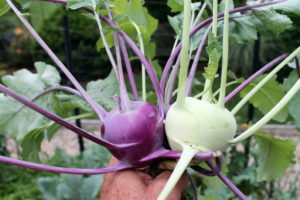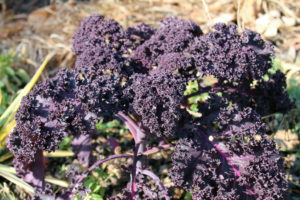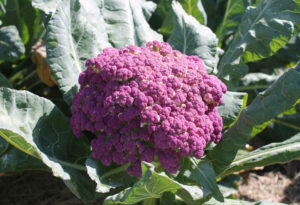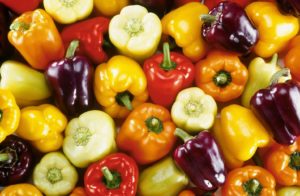The Power of Purple
May 8th, 2018
Trying to eat healthier? Eat purple.
Not so coincidentally, the plant pigments that give burgundy, bluish-black, and purple color to some plants’ leaves, roots and fruits – known as anthocyanins – are the same ones that act as antioxidants when eaten.
That’s true of other plants and colors, too. As a general rule, the more colorful a plant, the higher its nutrient value.
It’s why you’ll sometimes hear dieticians advise eating a “rainbow” of antioxidant-rich fruits and vegetables for high nutritional value and possible health benefits, such as lowering blood pressure, fighting cancer and aiding brain health.
Purple has become a particularly hot item in the vegetable garden – both for the health/nutrition potential and for adding beauty and color to the edible garden. Purple veggies stand out nicely among all the green.
Some vegetables are naturally rich in anthocyanins, but breeders have been developing and selecting new purple and burgundy versions of traditional green or bland-colored vegetables to boost their anthocyanin levels – and looks.
Here’s a dozen of my favorite purple “power vegetables” if you’d like to become a more colorful veggie gardener this season:
Carrots. Some have purple skins, others are purple throughout. Look for ‘Purple Haze,’ ‘Purplesnax,’ ‘Purple Dragon,’ ‘Purple Sun,’ ‘Deep Purple,’ ‘Purple 68,’ and ‘Black Nebula.’
Kale. This frost-tough leafy crop is a nutritional powerhouse even in its green form, but ‘Redbor’ matures from burgundy to deep purple in fall to a striking ornamental plant. ‘Scarlet’ and ‘Darkibor’ are two other good dark-leafed ones.
Kohlrabi. This little-known cabbage-family plant produces crunchy orbs low to the ground that have leaves jutting out around the perimeter. Most are green or creamy-white, but ‘Kolibri,’ ‘Azur Star’ and ‘Purple Vienna’ are purple varieties.
Cabbage. Both heirlooms and newer hybrids produce tight balls of rosy-purple leaves, including ‘Red Express,’ ‘Ruby Perfection,’ ‘Primero,’ ‘Ruby Ball,’ ‘Omero,’ and ‘Mammoth Red Rock.’
Broccoli. Varieties are available that produce both loose sprouts and larger heads with buds and stems of lavender or purple, including ‘Purple Crown,’ ‘Summer Purple,’ ‘Purple Peacock’ and ‘Miranda.’
Cauliflower. ‘Purple of Sicily’ is an heirloom light-purple cauliflower, while ‘Graffiti’ and ‘Depurple’ are two newer introductions that produce rich purple heads.
Leafy crops. Many salad greens come in burgundy to purple versions, such as the particularly cold-tough red orach and red mustard; the red stalks and leaves of several chard varieties; Asian greens such ‘Rosie,’ ‘Red Rain’ and ‘Red Pac’ pak choi, and leaf lettuces such as ‘Outredgeous,’ ‘Red Sails,’ ‘Red Salad Bowl,’ ‘Lollo Rossa,’ ‘Ruby Glow’ and ‘Vulcan.’
Potatoes. You’ve probably seen red-skinned potatoes such as the popular ‘Norland’ and ‘Red Pontiac,’ but lesser known are potatoes with rosy-red, purple and even bluish-purple flesh. These look especially nice on the plate even though their showy color is underground and out of sight in the garden. Check out varieties such as ‘Adirondack Blue,’ ‘Magic Molly,’ ‘All Blue’ and ‘Purple Majesty.’
Tomatoes. Many varieties rich in anthocyanins have dark-burgundy, bluish-purple and almost black tints. The new ‘Dancing with Smurfs’ cherry type is as close to purple as you’ll find, but also try ‘Brad’s Atomic Grape,’ Artisan™ ‘Bumble Bee Purple’ and the Indigo® series. Good “blacks” include ‘Black Beauty,’ ‘Cherokee Purple,’ ‘Black Krim,’ ‘Paul Robeson’ and ‘Black Brandywine’ (full-sized tomatoes) as well as ‘Black Cherry,’ ‘Purple Russian’ and ‘Black Pearl’ (cherry types).
Peppers. Both sweet bell peppers and hot peppers come with anthocyanin-boosted fruits that ripen purple to black. Bell ones include ‘Lilac Bell,’ ‘Purple Beauty,’ ‘Purple Star’ and ‘Tequila,’ while hot ones include ‘Purple Jalapeno’ and ‘Purple Lava.’
Beans. Both bush and climbing pole types are available with lavender to dark-purple pods. Purple bush types include ‘Amethyst,’ ‘Royal Burgundy,’ ‘Velour,’ ‘Purple Queen’ and ‘Purple Teepee,’ while purple pole types include ‘Purple Podded Pole,’ ‘Purple King’ and ‘Carminat.’
Asparagus. One of the few vegetables that come back from its own roots year after year, asparagus is now available with purple shoots instead of traditional green ones. Three now on the market are ‘Purple Passion,’ ‘Pacific Purple’ and ‘Sweet Purple.’











